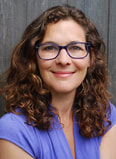 Guest Interview by Kelly Carey 24 Carrot Writing is excited to again welcome author Alison Goldberg to the blog! In 2018, Alison joined us a year after her debut picture book, I Love You for Miles and Miles, illustrated by Mike Yamada (Farrar, Straus and Giroux, 2017) had launched. Using all she had learned during that launch, Alison wrote the fabulous guest post, Goals For Promoting Your Debut Picture Book. We are thrilled to have Alison back as she prepares to launch Bottle Tops: The Art of El Anatsui, illustrated by Elizabeth Zunon (Lee & Low Books, 2022). This time we are chatting about research! Welcome back Alison! Your first picture book, I Love You for Miles and Miles is a heartfelt lyrical ode to the power of love using vehicle metaphors. Your new book, Bottle Tops: The Art of El Anatsui, is a powerful biography. What did you find surprisingly similar and unexpectedly different about working on both books? 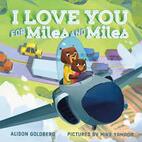 There are at least two parts of the writing process that I replicated across both books, and that I go through for all of my projects. This aspect of my process is reassuring to realize when it can sometimes feel like each book involves learning how to write all over again! The first is research. While I Love You for Miles and Miles is a sparse love poem, it was built on a foundation of information-gathering. I read truck catalogues, rode on cranes and trains, and observed construction sites. I wanted to find specific details that could convey the size and strength of vehicles in love metaphors. And I needed to know which truck is actually the biggest. (The dump truck!)  Of course, as a nonfiction biography, Bottle Tops hinged on research and required a much deeper dive. I read and watched everything I could find about El Anatsui’s art and life. Whether I’m writing a nonfiction picture book, a concept board book, or a middle grade fantasy, research underpins my work. The second necessary step in my writing process is finding the rhythm of a story. I think each book has its own unique sound. I wanted I Love You for Miles and Miles to be gentle and rolling, like a train lullaby, so the verse grew from there. 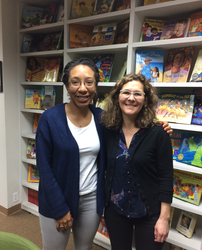 Meeting with Editor Kandace Coston at Lee & Low Books Meeting with Editor Kandace Coston at Lee & Low Books For Bottle Tops, I spent a lot of time listening to videos of El Anatsui’s talks. He has a very poetic way of describing his work, and I incorporated his specific descriptions—for example, the “language” of the marks made by a chainsaw, or how a new pot made from an old pot “acquires the strength” of the old pot. I paid close attention to how he characterizes his work and included several quotes from him in the book. My aim was to assemble these phrases into story beats and structure the story around them. The biggest difference in writing the two books came in the final stages. With Bottle Tops, there were additional steps to ensure accuracy. I sent drafts to El Anatsui and his archivist, Amarachi Okafor, and worked closely with my editor, Kandace Coston, while incorporating revisions. When did you first learn of El Anatsui’s art? What made you decide to write a picture book biography about him? 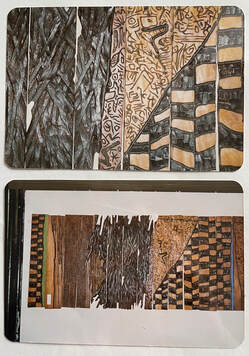 The photos I took of Ancient Cloth Series in 1995 The photos I took of Ancient Cloth Series in 1995 I’ve been inspired by El Anatsui’s work ever since I first saw one of his wood sculptures at the Artist’s Alliance Gallery in Accra, Ghana in 1995. I was a college student on a semester abroad and researching contemporary Ghanaian art. El Anatsui was living in Nigeria but his work was on display in the gallery, and it made a lasting impression on me. Many years later when I started writing for children, I thought his bottle top sculptures were an ideal topic for a picture book. They are so visually appealing and have a tactile quality that invites viewers to look at how they’re made. Up close, you can see how the metal is folded and shaped and connected by wire. The sculptures’ massive size is exciting. Stepping back, they transform from individual pieces of metal into a flexible form resembling cloth. In addition, El Anatsui’s artistic journey holds many lessons about how an artist can seek out their creative voice. He works with a material that’s close at hand and that evokes his history and environment. He has experimented over decades and is still finding new ways to make art. Artistic journeys are lifelong ones. El Anatsui is an acclaimed contemporary artist, and picture books are an important form to introduce children to major cultural figures. During my research for Bottle Tops, I saw how few picture books about African artists are currently on our library and bookstore shelves. We need many more. Black Artists Shaping the World by Sharna Jackson is a wonderful new resource that includes profiles of several contemporary African artists, and I encourage readers to seek out this book too. Can you tell us about the research you had to do for this book? What was your most effective research step? What did you stumble upon that was most exciting? What rabbit holes bore the most fruit? And which ones ate up the most unproductive time? 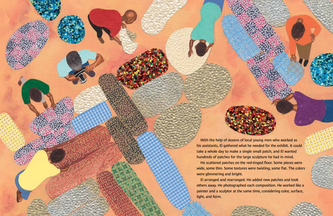 If you can’t tell already, I love research—especially rabbit holes. It’s hard to say whether there were rabbit holes that ate up unproductive time because I think it’s important to pursue a number of ideas and dig deep. I don’t really know what’s going to show up in the narrative until I start writing, so I want to be immersed. El Anatsui is a renowned artist and I was able to find many wonderful sources. While reading books and articles and watching videos, I searched for evocative images—the snapshots that could carry parts of the story. For example, when I learned that as a child, El Anatsui was fascinated with the forms of letters and copied the names he saw on doors before he could read, this felt like an important image to include to show his development as a visual thinker. Another image that stuck in my mind was how he assembled large sculptures by arranging patches on his studio floor while photographing the possibilities. I love Elizabeth Zunon’s gorgeous illustration of this moment—a bird’s-eye view on the creative process.
At some point when writing a biography, you have to take that leap and reach out to the person you are writing about, or another close source. Once I had a polished manuscript, I contacted the October Gallery in London which represents his work, to see if they would put me in touch with El Anatsui. I’m so grateful that they made an introduction! The response from him was the most exciting part of the process--and also the most necessary for my decision about whether I would pursue this project. Because El Anatsui is a contemporary artist, he continues to make new work, and during the time I was writing this book, additional sources became available too. I added quotes, but I’m glad I had focused on a specific time period. While his story continues, the book needed an arc. If I had left that open it would have been too tempting to include other work that he’s made since then. What advice would you give to aspiring writers? Write about what doesn’t let you go. Find your writing community to share and read works-in-progress, and to be a part of each other’s writing journey. Please share with us any events where readers (and writers!) can meet you in the upcoming weeks! I’m reading Bottle Tops at The Silver Unicorn in Acton, Massachusetts on June 11th at 11 am for an outdoor storytime. I’ll join illustrator Elizabeth Zunon for an event at the Book House of Stuyvesant Plaza in Albany, New York on July 9th at 1:30 pm. What is up next for you? And where can readers find you and your books? In addition to picture books, I’m writing a middle grade Jewish historical fantasy inspired by Yiddish folktales. I’ve been thinking a lot about El Anatsui’s concept of drawing from the past to tell new stories, and applying it to my own history and culture. I’m finding many rabbit holes! When I’m not deep in the research, you can find me online (and links for where to find my books) at www.alisongoldberg.com, Twitter @alisongoldberg, and Instagram at @alisongoldbergbooks. Thanks so much for having me on 24 Carrot Writing! Bottle Tops: The Art of El Anatsui releases on June 14 and is available for preorder now.
0 Comments
Leave a Reply. |
Peruse blogs for advice and tips from KidLit creatives.
Categories
All
Archives
April 2024
Click to set custom HTML
Click on the RSS Feed button above to receive notifications of new posts on this blog.
|
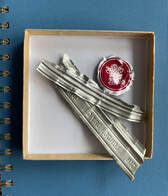
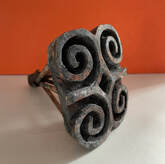
 RSS Feed
RSS Feed